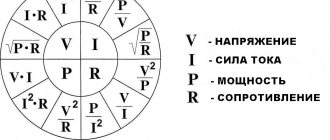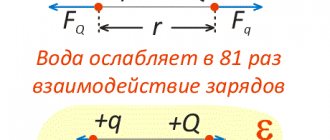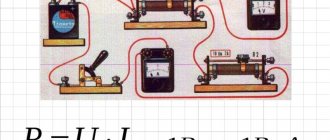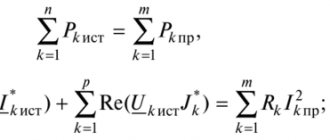Register Login
Publication date: February 1, 2015
In the texts published on this site, various terms that are names of physical quantities are often found. We studied a lot in the school physics course, but knowledge tends to be forgotten without constant use. In a series of notes united under the general heading “Remembering Physics” (we could call it “Back to School”) we will try to remind you what the basic terms mean, what physical quantities are hidden behind these terms, how they are related to each other, in what quantities they are measured. In general, to provide the basics needed to understand the published materials.
Our website is generally dedicated to methods and technologies for obtaining energy (specifically, from renewable sources). People need energy to heat and light their homes, in order to set in motion various mechanisms that perform work useful to people. That is, we ultimately need to obtain one of three types of energy - thermal, mechanical and light energy. As will be discussed below, physics distinguishes several other types of energy, but for us, these three types are primarily important. I’ll finish with the prefaces and give those definitions of energy that are accepted in physics.
Definition is the main thing for correct understanding
A definition or definition is a precise description of a term or concept. Without this, not a single concept can be fully revealed, especially when we are talking about physics that loves precision.
What is energy? Physics gives the following definition: Energy is a quantity that reflects the quantitative value of varying degrees of interaction and movement of matter, as well as its transition from one state to another. From the definition we can understand that energy is a substance that cannot disappear or appear from nowhere. It can only be transformed from one state to another. Depending on the different forms of motion and the degree of interaction of objects and matter, energy is divided into:
- mechanical;
- electromagnetic;
- chemical;
- internal;
- nuclear;
- thermal
Physics as a science considers consideration of the appropriateness of using the concept of “energy” necessary when its value remains unchanged during the movement of the body, which implies the homogeneity of the entire system over time.
Albert Einstein
Power, in terms of physical definition, is a quantity that determines the rate at which energy is consumed, transmitted, or converted by a system or one body. There is a direct connection between power and energy, which consists in a more common definition of this term. Power in the form of a formula can be represented as the ratio of the work performed during a specific period of time directly to the duration of its implementation.
The word “work” was heard. From the point of view of physics, work is a quantity that reflects the quantitative impact of some force applied to a body or system, which has a direction and depends on the movement of the object.
Examples of energy consumption calculations
How is power measured?
In order not to be surprised by large utility bills from the supply company, you need to have an idea of how to carry out simple calculations of energy consumption.
The main loads affecting electricity-related costs include:
- lighting;
- electric water heaters;
- heating system - electric boilers (boilers) and circulation pumps;
- split system.
Household appliances in the form of refrigerators, washing machines, vacuum cleaners are also included in the list of devices that affect the amount of energy consumption.
For water heater
As an example, we can consider the model of a wall-mounted instantaneous water heater from Thermex. Calculations are performed in the following sequence:
- specify the power of the water heater indicated in the technical data sheet; for Thermex City 6500 it is 6.5 kW;
- specify the average number of hours of work per day, for example, 3 hours;
- multiply the daily operating time by power: 3 * 6.5 = 19.5 kWh.
Next, determine the monthly consumption of electricity absorbed by this water heater:
30*19.5 = 585 kWh.
Instantaneous water heater Thermex City 650
Electric lamp
Lighting lamps are an active consumer of electricity. It doesn’t matter what kind of lamps the lamps in the apartment are equipped with: incandescent, fluorescent, LED - they all have a certain power. Lighting cost calculations are based on a simple relationship.
A 100 W lamp illuminated the room for 1 hour. This means that for its operation it was necessary to spend 100 Wh of energy, which is equal to 0.1 kWh. By summing up all the lamps connected to the lighting network and multiplying the result by the time the lighting is turned on, you can approximately calculate the daily energy costs.
Usually, to calculate operating time, they take the interval from the beginning of evening twilight until the hour when the residents of the home turn off the lights before going to bed.
Something to remember! With the same luminous flux, the power of the light source can be different depending on the nature of the radiation. Properly selected lamps allow you to save electricity without harming the quality of room lighting.
Comparative characteristics of light sources
For your information. One kWh can be spent to produce 88 loaves of bread, to develop 75 kg of coal, to extract 35 kg of “black gold” (oil) or to cultivate 0.25 hectares of soil.
Home heating boiler
To provide an apartment or residential building with heat, not only centralized heating or boilers running on solid or gaseous fuel are used. In different regions of Russia, preferences are given to different heat sources. Modern electric boilers not only heat water in the heating system, but also supply warm water to the kitchen and bathroom.
To make preliminary calculations of the energy consumption of such a boiler, you need to know:
- size of the area to be heated;
- rated (certified) power of the electric boiler;
- duration of the heating season (set individually, according to weather conditions).
Important! To express costs in monetary terms, it is necessary to clarify the cost of electricity in the region of residence.
Statistics show that in order to heat one unit of any building, you need to spend about 5-8 Wh. A more accurate cost value depends on the duration of the heating season and the magnitude of the numerical value of heat losses in relation to the total area of housing. Taking into account heat losses, it is necessary to know additional heat leaks through individual structural unheated parts of buildings.
Heat loss in a standard house
For your information. When calculating the consumption of an electric boiler, they are guided by the fact that to heat an area of 30 m3 (room area - 10 m2, ceiling height - 3 m) you need to spend 1 kW of electricity.
Consequently, a 10-kilowatt boiler can provide heat to an apartment of 100 m2.
There are two temperature modes: comfort and economy. Usually they focus on average temperatures.
Consumption of different types of fuel for heating
As an example, we can take the electric boiler EVPM - 6 220V. Its power is 6 kW, such a convector is designed to heat a room of 60 m2. This is an average two-room apartment in a panel house.
Unlike the electrical consumers discussed above, boilers operate around the clock during the heating season. Therefore, you can find out the monthly electricity consumption by multiplying the boiler power by the number of days.
For EVPM - 6 220V, the power consumption will be: 6 *24*30*7 = 30240 kW = 30.240 MW for the heating period.
Substituted values include:
- 6 – electric boiler power, kW;
- 24 – number of hours per day;
- 30 – average number of days in a month;
- 7 – average number of months in the heating season.
The use of individual boilers makes significant adjustments to the timing of the heating season. Significant savings in electricity consumption by heating boilers are achieved by inserting a circulation pump into the heating circuit. It ensures rapid movement of coolant through pipes from the boiler to the radiators. Working in automatic mode, although such a device consumes electricity, it consumes much less than a boiler operating in maximum mode.
Circulation pump in the heating system
A simple multiplication of the power of the device that consumes electricity during its operation allows you to calculate the electricity consumption in kilowatts per hour. As a result of transformations of units characterizing energy parameters, it is possible to calculate the necessary quantities: joules, calories, watts and kWh.
What is energy equal to in physics?
There are several different formulas used to calculate energy and work. Namely energy and work, since without going into deep details, it is important to note that these two concepts are identical, since both of these quantities are usually measured quantitatively in single quantities.
So, depending on the branch of physics, different formulas are used to calculate its final value. If we take the “mechanics” section of physics, then the energy is equal to the force applied to the body multiplied by the length of movement. In another branch of physics, called thermodynamics, energy is calculated as the product of pressure and volume. In electrical engineering, energy will be calculated as the product of power and time.
The relationship between energy and power is very close, and the concepts should not be confused. If we talk about energy from the point of view of a simple layman, then first of all, when mentioning the operation of household appliances, no one talks about the energy consumed per second, but usually the interest is how much energy the device consumes in a certain amount of time. This is what is called power, which is calculated by the formula: energy divided by time. The best known energy is electrical energy, measured in watts.
It turns out that energy and power are different sides of the reflection of one phenomenon, but power reflects not the quantitative amount of absorbed energy, but the qualitative one, that is, the rate of its absorption.
From joule to kilowatt
Since 1 kW is one thousand watts, the relationship between these two system quantities is considered initially based on one watt.
Joule concept
How many watts are in a kilowatt
When applied to an electrical circuit, 1 J is equal to the work that electric field forces do in 1 second (s) to maintain a current of 1 ampere (A) at a voltage of 1 volt (V). In other words, 1 kJ = 1 kWh.
Converting joules to kilowatt hours
To convert a known number of joules into kilowatt-hours, this is done by direct and reverse conversion of mechanical and electrical energy. This is necessary when performing calculations of the performance of electrical machines: engines and generators.
Important! For calculations, the well-known relation 1 MJ = 0.277(7) kW⋅h is used, from which it follows that 1 kW⋅h = 3.6 MJ. Mega is 1*106.
For example, you need to convert 15 MJ to kWh . To do this, multiply 15 by 0.277:
15*0.277 = 4.15 kWh.
If it is necessary to determine how many joules are 15 kW h , calculate as follows:
15*3.6 = 54 MJ = 54000 kJ = 54*106 J.
The fairness of such calculations is based on the fact that the implementation of the transition to another measurement system was carried out taking into account time. One hour in minutes is equal to 60 minutes. A minute, in turn, consists of 60 seconds, and there are 3600 of them in one hour. One kilowatt contains 1000 watts. Multiplying the number of watts by the number of seconds gives the size of one joule - 3.6 million (MJ). Recording energy consumption in kilowatts for billing calculations has made it easier to evaluate meter readings.
Electric meter
Changing the dimension of power units
You can often come across questions related to the dimension of P units . The most common questions are:
- what is a kilowatt?
- how many kWh in kW;
- how much is 1kW equal to watt;
- 1 kW is how much watt or quat is it;
- how many watts are in 1 kW;
- what is the number of kilowatts per kilowatt hour?
Despite all the variations of letter abbreviations, everything is simple. A kilo is a thousand, so 1 kW is equal to 1000 watts (W). This is also true for volts - 1 kilovolt (kV) is equal to 1000 volts. One thousand kilowatts is equal to 1 megawatt (MW). The multiplicity of units helps to clearly determine the ranks of power values P.
Using these data, it is convenient to plan your family budget. By multiplying the power consumed by the device by the amount of time it is in use, you can estimate its daily consumption. Multiplying the daily load by the number of calendar days in a month allows you to accurately estimate the energy consumption of the entire home.
Power unit multiplicity table
Energy work
The work done by energy is a more complex concept, the definition of which requires knowledge that there are conservative forces. Conservative forces are forces whose work does not depend on the paths of motion of bodies and is determined solely by the point at which the movement begins and ends. A striking example of such forces is the well-known attraction. The energy that drives bodies during the action of conservative forces on them is called potential. According to the theorem, the work done in this case is a quantity that reflects the change in potential energy, which is taken with the opposite sign.
Basics of Preservation and Conversion
It is known from the fundamentals of physics that the total force of any object, regardless of the time and place of its stay, always remains a constant value; only its constant components (Ep) and (Ek) are transformed.
The transition of potential energy into kinetic energy and back occurs under certain conditions.
For example, if an object does not move, then its kinetic energy is zero; only a potential component will be present in its state.
Conversely, what is the potential energy of an object, for example, when it is on the surface of the Earth (h=0)? Of course, it is zero, and the E of the body will consist only of its component Ek.
But potential energy is the power of movement. As soon as the system rises to a certain height, after which its Ep will immediately begin to increase, and Ek will, accordingly, decrease by the same amount. This pattern is visible in the above formulas (1) and (2).
For clarity, let’s give an example with a stone or ball being thrown. During the flight, each of them has both a potential and a kinetic component. If one increases, then the other decreases by the same amount.
The upward flight of objects continues only as long as the reserve and strength of the movement component Ek is sufficient. As soon as it runs out, the fall begins.
But it’s not hard to guess what the potential energy of objects at the highest point is, it’s maximum.
When they fall, the opposite happens. When touching the ground, the level of kinetic energy is at its maximum.
The effect of this law is observed not only in ordinary life, but also in scientific theories. Briefly about one of them.
Since there is no interaction between the numerous particles of an ideal gas, the potential component of the described phenomenon of molecules is constantly zero. This means that the entire internal force of ideal gas particles is defined as the average kinetic force and is calculated using the above formula (1).
Attention! Nowadays, on desks you can see a souvenir called “Newton’s pendulum.” This device perfectly demonstrates the conversion process. If the outermost ball is moved to the side and then released, after the collision it transfers its energy charge to the next ball, and that one to its neighbor.
Types of energy in physics
Kinetic and potential energies, formulas
Scientists have long given an answer to the question, for example, how to find kinetic energy. Already in the middle of the 19th century. English mechanic William Thomson used the definition “kinetic” in his experiments. But modern life has forced us to conduct in-depth research into the transformation of one species into another.
This is interesting! What does speed show during uniform linear motion: formula
Source: tvercult.ru
Basic theoretical information
Mechanical work
The energy characteristics of motion are introduced on the basis of the concept of mechanical work or work of force . The work done by a constant force F is a physical quantity equal to the product of the force and displacement modules multiplied by the cosine of the angle between the vectors of force F and displacement S:
How to successfully prepare for the CT in physics and mathematics?
In order to successfully prepare for the CT in physics and mathematics, among other things, it is necessary to fulfill three most important conditions:
- Study all topics and complete all tests and assignments given in the educational materials on this site. To do this, you need nothing at all, namely: devote three to four hours every day to preparing for the CT in physics and mathematics, studying theory and solving problems. The fact is that the CT is an exam where it is not enough just to know physics or mathematics, you also need to be able to quickly and without failures solve a large number of problems on different topics and of varying complexity. The latter can only be learned by solving thousands of problems.
- Learn all the formulas and laws in physics, and formulas and methods in mathematics. In fact, this is also very simple to do; there are only about 200 necessary formulas in physics, and even a little less in mathematics. In each of these subjects there are about a dozen standard methods for solving problems of a basic level of complexity, which can also be learned, and thus, completely automatically and without difficulty solving most of the CT at the right time. After this, you will only have to think about the most difficult tasks.
- Attend all three stages of rehearsal testing in physics and mathematics. Each RT can be visited twice to decide on both options. Again, on the CT, in addition to the ability to quickly and efficiently solve problems, and knowledge of formulas and methods, you must also be able to properly plan time, distribute forces, and most importantly, correctly fill out the answer form, without confusing the numbers of answers and problems, or your own last name. Also, during RT, it is important to get used to the style of asking questions in problems, which may seem very unusual to an unprepared person at the DT.
Potential energy of position at high altitude
Formula (1) is correct provided that the acceleration of gravity g is constant over the entire height of the rise, i.e. in case of rising to a relatively low height. In the gravitational field of any celestial body, the force of gravity and, accordingly, the acceleration of free fall of the body decreases in proportion to the square of the distance from the center of this body. Therefore, when ascending to a high altitude, it should be taken into account that g = g(h) and, therefore, G = G(h):
Here: W is the work against the gravitational force (Joule), G is the gravitational force with which two bodies are attracted to each other (Newton), ma is the mass of the first body (kg), mb is the mass of the second body (kg), r is the distance between the centers of mass of bodies (meter), r1 is the initial distance between the centers of mass of bodies (meter), r2 is the final distance between the centers of mass of bodies (meter), γ is the gravitational constant 6.67 10 -11 (m 3 /(kg sec 2 )),











